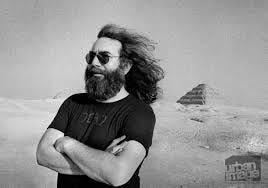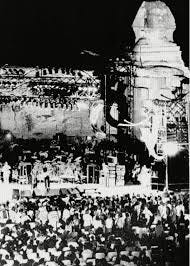Pyramid scheme: The Dead & Kesey in Egypt
Sun, sand and desert rock
IN THE CRADLE of an ancient civilisation, Ken Kesey and his Merry Pranksters fell to earth during the early autumn of 1978, delivering the near-mystical majesty of their regular musical troubadours the Grateful Dead to thousands of fans in a three-day desert residency.
ANTONIO PINEDA, a keen-eyed chronicler of the countercultural scene in San Francisco, whom we last encountered in the mid-Sixties acid swirl of California with Neal Cassady, was again present, this time 7,500 miles from the Bay Area in Egypt, to record the occasion: sounds and visions, psychedelic mirages, sunburnt landscapes and a stunning lunar nightfall.
In this fresh and dynamic reflection, reminiscent of the New Journalism, our frequent guest writer recreates the intense vibrations – shimmering, simmering – of this magical sojourn in the timeless land of the pharaohs, a rock’n’roll re-telling perhaps of the Arabian Nights…
By Antonio Pineda
My next encounter with Ken Kesey would be in Cairo. I arrived in Egypt in 1978 to dig the Grateful Dead’s three-day gig under the shadows of the pyramids. Paul Gaylon Ennis greeted me at the Mena House Oberoi Hotel. Gaylon was a former actor with the Living Theater. The photographer Bernie Boston had captured Paul in a photograph entitled Flower Power. Paul was captured putting a flower into the rifle barrel of a Guardsman shot on October 21st, 1967. The occasion was the March on the Pentagon to end the War in Vietnam.
The iconic image, nominated for a Pulitzer Prize, has been mistakenly identified via suggestions that it featured gay icon Hibiscus or Super Joel Tornabene. The psychedelic underground, represented by Linda Kelly, author of Deadheads: Stories from Fellow Artists, Friends & Followers of the Grateful Dead and editor of the Haight Street Voice, has since correctly attributed it to be Paul Gaylon Ennis in a special edition of HSV dedicated to Paul. He and I repaired to the hotel bar.
Two young Egyptian lads greeted us. They introduced themselves as Mudi and Hossain El Amin. Their father Mohammed El Amin was an important film director. Impeccably turned out in mod jeans and t-shirts, sporting long hair and rakish moustaches, they represented the new wave of Egyptian youth. They invited us to join them at the Gezira Sporting Club, a posh private venue and most prestigious country club in Cairo.
We strolled the lush grounds of the Oberoi. Ken Kesey and pro basketball star Bill Walton approached us. The muscular Kesey and tall athletic Walton cast quite an impression. Paul introduced them to our new Egyptian pals, who graciously offered them an open invitation to tour Mohammed El Amin’s film studios in Cairo. Kesey and Walton were impressed by their hospitality.
Mudi and Hossain charmed them further with an invitation to join us at the Gezira Sporting Club. They politely declined as they were otherwise engaged, and we departed in search of a taxi. The Egyptian brothers enquired who those chaps were. We explained to their amusement that Bill was a famous pro basketball player and Kesey was a prominent author.
The final show was on September 16th, under the magick spell of a full lunar eclipse. A crowd of 2,000 grooved under the stars, dancing as the planets coursed through the constellations. A girl, swathed in tie dies with bells on her ankles and toes, offered Paul and me a swig of orange juice from a bottle. We politely acquiesced and realized soon afterwards we had been pranked and dosed with a powerful psychedelic. Such are the vagaries of life.
The Dead played with a new line-up that included Donna and Keith Godchaux. Keith engaged me in conversation looked me up and down and enquired, ‘Hey man, are you Egyptian?‘ Bill Kreutzmann fell offa horse, broke a bone in his hand and played the gigs with one hand.
The piano tuner never showed, so the gig played on with an out-of-tune piano. The sound mix on the first night was faulty, and some vocals were scratchy. ‘Fire on the Mountain’ was my fave performance. The lyrics seemed to burn like Ra, the sun god in Egyptian iconography.
Pictured above: Jerry Garcia with pyramid
‘Good Lovin’’ rocked the crowd, dancing under the tapestry of heavenly stars. The Sound and Light Theater in Giza reverberated with the Dead’s repertoire in the shadows of the iconic structures, the Sphinx and the pyramids. Phil Lesh said: ‘It sort of became my trip ‘cos I wanted to gig in places of power. You know, power that’s been preserved from the ancient world.’ When Phil and I crossed paths during the event, he was hail fellow well met and called me Antoine. The wondrous nature of the exalting experience overcame all the setbacks.
Bobby Weir remarked: ‘I got to the point where, when the head of the Sphinx aligned with the pyramid, it was as if I went back into eternity.’ Jerry Garcia performed like a shaman. His leonine hair and pharaonic presence, highlighted by his masterful playing, symbolised his central influence on this remarkable gathering.
The gig was a seminal event for me, as I had rubbed shoulders with the Dead since they were the Warlocks and they gigged at Marty Balin’s club the Matrix. I used to hang out at the hip clothing boutique Mnasidika with Peggy Caserta, who dressed the Dead, in their early incarnation when Jerry was known as Captain Trips. Peggy would go on to write two books about her dear friend Janis Joplin.
I would walk by the Dead House on Ashbury Street where they often hung out on the stairs and exchanged greetings. The Dead regularly ate at Mama’s Piroshki Parlor across the street from the Straight Theater and were always warm and welcoming. Now, Cairo was the ultimate hangout.
Pictured above: The Dead live as the Sphinx looks on
Bill Walton sat regally on stage while Mountain Girl and promoter Bill Graham rolled to the music of Hamza El Din, who played his oud surrounded by dancing tribesman on stage. After the gig, impresario Graham had organized a fête to be celebrated at Sahara City, a tented oasis in the desert. Camels or horses were provided for the guests as transportation. I chose an Arabian stallion.
The horses’ hooves drummed on the sands as I rode in a paisley dream. Antony and Cleopatra trysted to erotic music. I entered an enchanted garden of earthly delights. Precious waters flowed in streams nurturing figs, roses and pomegranates. Gold and bronze statues exuded an aura of glory and immortality. Nubile houris played finger cymbals and welcomed me to partake of these celestial pleasures. The naked splendor of Nuit and the mysterious Anubis, god of the underworld, stared down upon us.
The poet set sail from the land of misty Thule. The ship flew the flag of the Jolly Roger, crewed by corsairs, valkyries and centaurs. They partook of a pinch of psychedelic in order to soar angelic and traverse the seven seas to reach their destiny. The Odist disembarked in Alexandria, mounted an Arabian stallion of burnished steel whose hooves danced over the sands of Time, as the steed galloped past the eternal Sphinx, illuminated by the desert stars falling on the land.
In the distance the stallion could see his destination, as stardust fell over the tented oasis of Sahara City. The poet dismounted at the oasis and, of all the heroes and temptresses in this fable, naught but the bard survives to tell the tale.
Pictured above: The Dead’s characteristic symbol
I entered this amazing desert night club. Paul and I socialized with the guests, ate from the exotic buffet that offered the delicacies of Egyptian antiquity and dug the performance of divine belly dancers. The mushroom shaped dumbekis throbbed as drummers played trance rhythms. The dancers undulated to ouds, playing finger cymbals, accentuating the music with hips and torsos.
Ken Kesey made an entrance worthy of a Hollywood superstar. Kesey was attired as a Bedouin tribesman, in the fashion of iconic actor Peter O’Toole, who portrayed T. E. Lawrence in the classic 1962 film Lawrence of Arabia, shot by legendary director David Lean. He was every inch the star of his own movie. King of the desert, Kesey swaggered in his cinematic costume like the mythical hero he was.
The metaphor was complete. He became a psychonaut, adventurer, superhero and master of all he surveyed. Kesey conveyed the charisma and insolence, flamboyance and intellectual prowess, that O’Toole personified on the greatest cinematic stage of all, the eternal Egyptian desert. It was an act no one could follow.
Pictured above: Ken Kesey’s chic sheikh
The chariot of the sun had begun its ascent across the skies of dawn as we emerged from the royal court. My noble horse stood at the ready. Ali his handler assured me that he had watered, fed and rested the stallion. I mounted the saddle, jammed my boots into the stirrups, grabbed the reins, as the steed broke into a canter in order to beat the unrelenting sun’s rays back from whence we came.
Today’s political world of conflict zones in Gaza, Ukraine, Myanmar and climate change, the apathy of this generation’s revolutionary political action against the new world orders and dystopian authoritarian regimes reinforce the halcyon days of yesteryear as cinematic moments in time.
The Beats and their countercultural heirs, like Kesey and the Dead, sought a Brave New World. Perhaps utopian society is a flawed concept but, as the USA flounders in snake oil salesmen politicians, it’s preferable indeed to the dystopian blueprint of a disillusioning present.
Editor’s note: You can find other writing by Antonio Pineda at R&BG. Check out ‘Kaleidoscopia! Kesey, Cassady & a revolution in the mind’, January 27th, 2024; ‘McClure reads but Dead go missing’, November 24th, 2023, and ‘Meeting McClure & Morrison: Beat dreams & a mescaline memory’, August 20th, 2023






Kenny Weir writes from Melbourne, Australia: I enjoy your posts! I was living in London in 78 and gave some thought to trying to get to the Egypt gigs. But I was seriously broke at the time, so probably best it didn't eventuate.
Like a lot of young Kiwis and Aussies, I'd ended up in London because that's how it was done - and there was work to be had. I'd spent the previous four months or so hitchhiking across the US, a head full of the Beats and the Dead and all the rest.
Saw the GD at Winterland courtesy of my friends at BAM magazine - and now have the box set! So in London, I was a mix-up of bohemian Americana buff and wastrel/drinker who could (and did), nonetheless, throw himself into then then ascendant punk thing.
The Egypt scheme was a chimera more than anything - no money, plus (pre-internet, of course) details were scarce. My life journey upon my return to NZ and then a move to Australia in 86 has embraced many twists and turns, musical and otherwise.
I had a GD rebirth about 10 years ago, bought a bunch of stuff. They still have a big place in my heart, but the repertoire-on-repeat I find unlistenable these days. So I get those same jollies from all sorts of jazz, old, new, avant, free and way more. Also blues, gospel, bluegrass etc etc. Tonight it's been crusty old '20s jazz!
The Beats? The fascination remains, hence my enjoyment of your works. But TBH I doubt I could do even a page of most them these days. Similarly, those passions and interest these days get fulfilled in old-school hard case crime and noir and SF. Ross MacDonald is The Best!!! These days I am a retired hack journo and some-time food blogger.
Brilliant!!